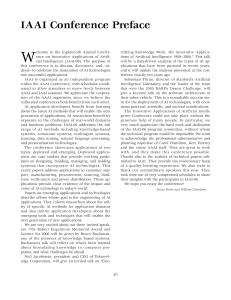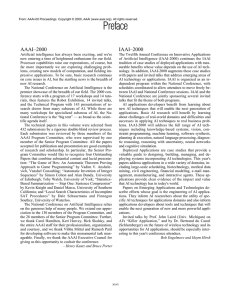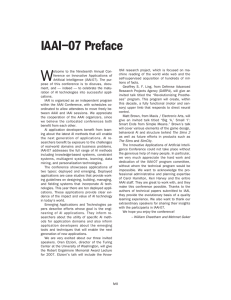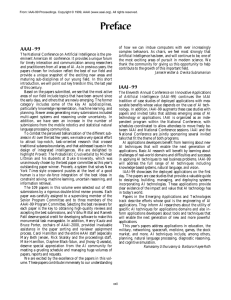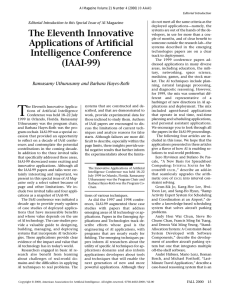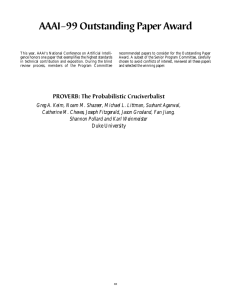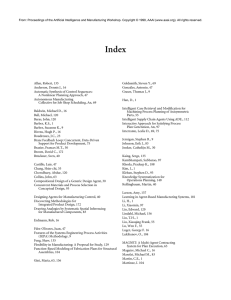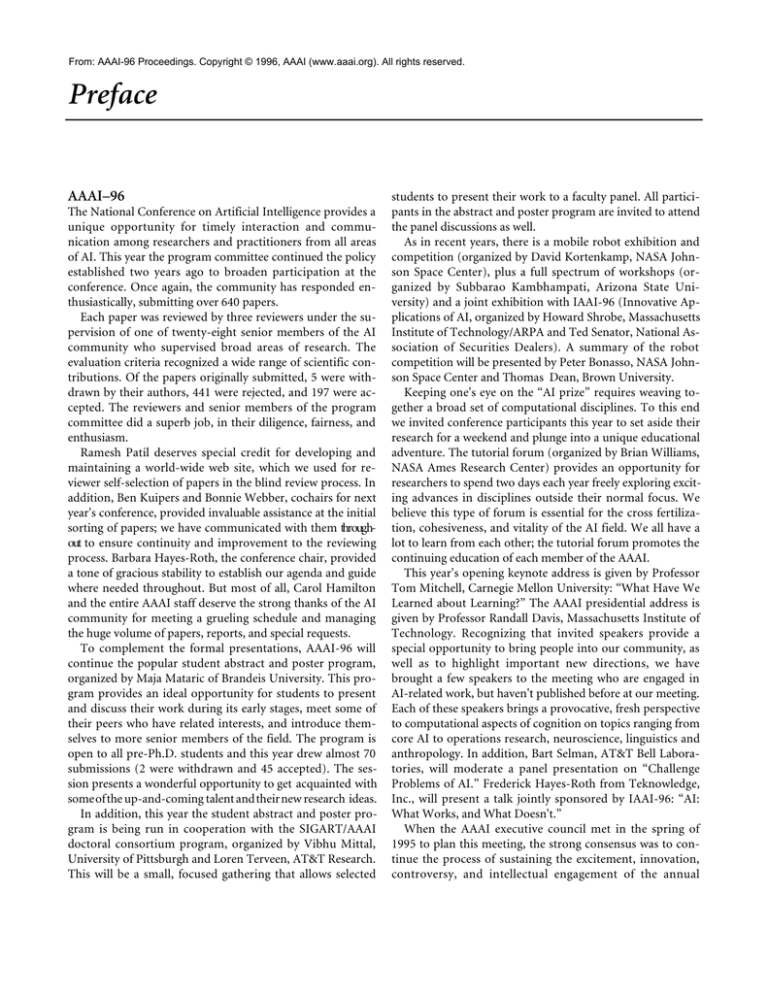
From: AAAI-96 Proceedings. Copyright © 1996, AAAI (www.aaai.org). All rights reserved.
Preface
AAAI–96
The National Conference on Artificial Intelligence provides a
unique opportunity for timely interaction and communication among researchers and practitioners from all areas
of AI. This year the program committee continued the policy
established two years ago to broaden participation at the
conference. Once again, the community has responded enthusiastically, submitting over 640 papers.
Each paper was reviewed by three reviewers under the supervision of one of twenty-eight senior members of the AI
community who supervised broad areas of research. The
evaluation criteria recognized a wide range of scientific contributions. Of the papers originally submitted, 5 were withdrawn by their authors, 441 were rejected, and 197 were accepted. The reviewers and senior members of the program
committee did a superb job, in their diligence, fairness, and
enthusiasm.
Ramesh Patil deserves special credit for developing and
maintaining a world-wide web site, which we used for reviewer self-selection of papers in the blind review process. In
addition, Ben Kuipers and Bonnie Webber, cochairs for next
year's conference, provided invaluable assistance at the initial
sorting of papers; we have communicated with them throughout to ensure continuity and improvement to the reviewing
process. Barbara Hayes-Roth, the conference chair, provided
a tone of gracious stability to establish our agenda and guide
where needed throughout. But most of all, Carol Hamilton
and the entire AAAI staff deserve the strong thanks of the AI
community for meeting a grueling schedule and managing
the huge volume of papers, reports, and special requests.
To complement the formal presentations, AAAI-96 will
continue the popular student abstract and poster program,
organized by Maja Mataric of Brandeis University. This program provides an ideal opportunity for students to present
and discuss their work during its early stages, meet some of
their peers who have related interests, and introduce themselves to more senior members of the field. The program is
open to all pre-Ph.D. students and this year drew almost 70
submissions (2 were withdrawn and 45 accepted). The session presents a wonderful opportunity to get acquainted with
some of the up-and-coming talent and their new research ideas.
In addition, this year the student abstract and poster program is being run in cooperation with the SIGART/AAAI
doctoral consortium program, organized by Vibhu Mittal,
University of Pittsburgh and Loren Terveen, AT&T Research.
This will be a small, focused gathering that allows selected
students to present their work to a faculty panel. All participants in the abstract and poster program are invited to attend
the panel discussions as well.
As in recent years, there is a mobile robot exhibition and
competition (organized by David Kortenkamp, NASA Johnson Space Center), plus a full spectrum of workshops (organized by Subbarao Kambhampati, Arizona State University) and a joint exhibition with IAAI-96 (Innovative Applications of AI, organized by Howard Shrobe, Massachusetts
Institute of Technology/ARPA and Ted Senator, National Association of Securities Dealers). A summary of the robot
competition will be presented by Peter Bonasso, NASA Johnson Space Center and Thomas Dean, Brown University.
Keeping one's eye on the “AI prize” requires weaving together a broad set of computational disciplines. To this end
we invited conference participants this year to set aside their
research for a weekend and plunge into a unique educational
adventure. The tutorial forum (organized by Brian Williams,
NASA Ames Research Center) provides an opportunity for
researchers to spend two days each year freely exploring exciting advances in disciplines outside their normal focus. We
believe this type of forum is essential for the cross fertilization, cohesiveness, and vitality of the AI field. We all have a
lot to learn from each other; the tutorial forum promotes the
continuing education of each member of the AAAI.
This year's opening keynote address is given by Professor
Tom Mitchell, Carnegie Mellon University: “What Have We
Learned about Learning?” The AAAI presidential address is
given by Professor Randall Davis, Massachusetts Institute of
Technology. Recognizing that invited speakers provide a
special opportunity to bring people into our community, as
well as to highlight important new directions, we have
brought a few speakers to the meeting who are engaged in
AI-related work, but haven't published before at our meeting.
Each of these speakers brings a provocative, fresh perspective
to computational aspects of cognition on topics ranging from
core AI to operations research, neuroscience, linguistics and
anthropology. In addition, Bart Selman, AT&T Bell Laboratories, will moderate a panel presentation on “Challenge
Problems of AI.” Frederick Hayes-Roth from Teknowledge,
Inc., will present a talk jointly sponsored by IAAI-96: “AI:
What Works, and What Doesn't.”
When the AAAI executive council met in the spring of
1995 to plan this meeting, the strong consensus was to continue the process of sustaining the excitement, innovation,
controversy, and intellectual engagement of the annual
meeting. As cochairs we have been delighted and honored to
help produce the volume you are now holding. But the real
credit goes to the researchers, reviewers, and the AAAI staff
who attended to every detail to make the conference and proceedings of the highest quality.
–
Dan Weld & Bill Clancey
Program Cochairs, AAAI–96
IAAI–96
In this, the Eighth Annual Conference on Innovative
Applications of Artificial Intelligence, we present a set of
eighteen application case studies that illustrate the broad
spectrum of society being affected by artificial intelligence
technology. The application domains range from monitoring
frog populations in the outback of Australia to processing
email for the Clinton White House. The technical range is
similarly impressive: neural networks, rule based reasoning
and case-based reasoning all play a role in these applications.
Sixteen systems were chosen as winners of the annual
Innovative Applications of Artificial Intelligence award.
Three of these papers are in the telecommunications domain.
Pacific Bell’s system helps localize failures in telephone cable
networks. GTE has two winning applications. The first helps
to optimize performance in cellular phone networks; the
second SSCFI, is an autonomous fault isolation system.
Two of the awards are for engineering applications. BULL
HN presents a technique, called dimensional unfolding, which
is used in sheet metal cutting to help optimize the packing of
shapes. Schlumberger, one of the earliest companies to apply
AI technology, has developed a neural-network based solution to the problem of predicting the quality and performance of the cements used to line the walls of boreholes.
Four systems were given awards for applications that help
in knowledge and information management. A team at MIT
has worked with the White House office of media affairs to
develop an information distribution system that includes
email and the world wide web; their application is an expert
system that processes the large number of bounced mail
messages received daily. Chase Manhattan Bank has begun to
use email as a means for direct communication with
customers; they have developed an application called EZ
Reader that uses rule-based and cased-based technologies to
decide how to process each incoming message from a
customer. Reuters has developed an application to collect
and share knowledge in its world-wide customer-support
organization. Fannie Mae has developed KARMA, a system
for managing business rules from specification through to
implementation.
Four case studies were given awards for financial
applications. The Settlement Analysis Expert at Frito-Lay
helps reconcile discrepancies in the management of inventory
in their retail distribution system. Price Waterhouse has
developed Comet, a model-based reasoning system that helps
auditors to improve the controls in their clients’ finanical
management systems. Swiss Bank has developed a system for
Asset and Liability management in investment portfolios and
Equifax Check Services has developed EASY, an expert system for authorizing checks.
Three awards were given to systems that help in business
operations. The first, from J Sainsbury PLC, helps manage
the logistics of supplying a very large chain of retail stores. An
expert system from SIGNAL Versicherungen in Germany
helps advise insurance salemen on how to better meet the
clients needs. NASA’s Personnel Security Processing Expert
System helps personnel managers to decide what security
clearances employees need to obtain.
Finally, we present two other case studies: The first is a
retrospective from United Healthcare that looks at how an
expert system presented at an earlier IAAI conference has
evolved over time. The other is an unusual system from
Australia, just beginning its deployement, which uses
machine learning techniques to recognize the vocalizations of
different frog species so that researchers can automatically
monitor the population statistics of these species as other
species move into their habitat.
The application of AI technology is proceeding rapidly
with several new areas seemingly poised to take off. We have
invited several speakers to present surveys of new areas of
potential application of AI: Robert Abarbanel of Boeing will
talk about how AI may begin to play a significant role in the
design of commercial aircraft. Richard Lathrop, from the
University of California at Irvine, will talk about how AI will
play a role in computational biology. George Doddington, of
the National Security Agency and SRI International, will talk
about the emerging areas of application for speech
technology. Mark Boddy, from the Honeywell Technology
Center, will discuss applications of AI technologies in planning and scheduling. Doug Smith, of the Kestrel Institute,
will talk about applications of AI in software engineering.
Finally, Usama Fayyad of Microsoft will discuss applications
for knowledge discovery and data mining techologies.
The interaction between basic and engineering research in
our field has never been so important. Initially, the IAAI
conference was held as a standalone event to highlight the
successful application of AI research. For several years, the
IAAI has been held at the same time and place as the AAAI
National Conference on Artificial Intelligence (or with IJCAI
when it is held in North America). We are in the process of
integrating these two separate conferences into one larger
conference with several tracks. This will help our field to
move research results into practice more readily and to more
effectively evaluate the research through practical experience.
IAAI and NCAI are jointly sponsoring a talk by Rick HayesRoth of Teknowledge which looks at this interaction between
theory and practice.
–
Howard Shrobe & Ted Senator
Program Chair Program Cochair, IAAI–96

